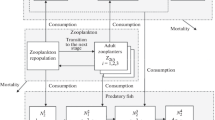Abstract
We consider a method for mathematical modeling of ecologo-biological systems based on computational studies that unites formal and informal, analytic and imitational approaches. The method is based on complex studies that include a complete set of operations, from filtering biological information to constructing a set of interrelated models, including simplified ones, that admit an analytic (parametric) study. This lets us overcome the disadvantages of purely imitational approaches: they are restricted by numerical experiments and often have huge models. The proposed approach has been used to analyze animal population fluctuations with the tundra community model “vegetation-lemmings-arctic foxes.” As a result of our studies, we formulate hypotheses on leading mechanisms that determine the fluctuations of tundra animal populations.
Similar content being viewed by others
References
Volterra, V., Thèorie mathèmatique de la lutte pour la vie, Paris: Gauthier-Villars, 1931. Translated under the title Matematicheskaya teoriya bor’by za sushchestvovanie, Svirezhev, Yu.M., Ed., Moscow: Nauka, 1976.
Kostitsyn, V.A, Evolyutsiya atmosfery, biosfery i klimata (Atmosphere, Biosphere, and Climate Evolution), Moscow: Nauka, 1984.
Kolmogorov, A.N., Kachestvennoe izuchenie matematicheskikh modelei dinamiki populyatsii (A Qualitative Study of Mathematical Models of Population Dynamics), Moscow: Nauka, 1972.
Murray, J.D., Mathematical Biology, vol. 1: Introduction, Springer, 2002. Translated under the title Matematicheskaya biologiya, vol. 1: Vvedenie, Moscow: R&C Dynamics, 2009.
Bratus’, A.S., Novozhilov, A.S., and Platonov, A.P., Dinamicheskie sistemy i modeli biologii (Dynamical Systems and Biological Models), Moscow: Fizmatlit, 2010.
Sarancha, D.A., Kolichestvennye metody v ekologii. Biofizicheskie aspekty i matematicheskoe modelirovanie (Quantitative Methods in Ecology: Biophysical Aspects and Mathematical Modeling), Moscow: Mosk. Fiz.-Tekh. Inst., 1997.
Forrester, J.W., World Dynamics, Cambridge: Wright-Allen, 1971. Translated under the title Mirovaya dinamika, Moscow: Mir, 1978.
Peck, S.L, The Hermeneutics of Ecological Simulation, Biol. Philos., 2008, vol. 23, pp. 383–402.
Medvinskii, A.B., Bobyrev, A.E., Burminskii, V.A., Kriksunov, E.A., et al., A Conceptual Mathematical Model of Aquatic Communities in Lakes Naroch and Myastro, Biofizika, 2009, vol. 54, no. 1, pp. 120–125.
Novosel’tsev, V.N., Mathematical Modeling in Biology: Systems Capable to Live and Die, Autom. Remote Control, 2006, vol. 67, no. 6, pp. 835–855.
Orlov, V.A., Sarancha, D.A., and Shelepova, O.A., A Mathematical Model of Lemming (Lemmus Dicrostonyx ) Population Dynamics and Its Application to Populations of Eastern Taymyr, Ekologiya, 1986, no. 2, pp. 43–51.
Aleksandrov, G.A., Armand, A.D., Belotelov, N.V., Vedyushkin, M.A., et al., Matematicheskie modeli ekosistem. Ekologicheskie i demograficheskie posledstviya yadernoi voiny (Mathematical Models of Ecosystems. Ecological and Demographical Consequences of Nuclear Warfare), Dorodnitsyn, A.A., Ed., Moscow: Nauka, 1986.
Pitelka, F.A. and Batzli, G.O., Population Cycle of Lemmings near Barrow, Alaska: A History Review, Acta Theriologica, 2007, vol. 52, no. 3, pp. 323–336.
Chernyavskii, F.B., Lemming Cycles, Priroda, 2002, no. 10, pp. 34–40.
Turchin, P., Complex Population Dynamics: A Theoretical/Empirical Synthesis, Princeton: Princeton Univ. Press, 2003.
Nedostupov, E.V., Sarancha, D.A., Chigerev, E.H., and Yurezanskaya, Yu.S., On Certain Properties of One-Dimensional Unimodal Mappings, Dokl. Ross. Akad. Nauk, 2010, vol. 430, no. 1, pp. 23–28.
Glushkov, V.N., Nedostupov, E.V., Sarancha, D.A, and Yufereva, I.V., Komp’yuternye metody analiza matematicheskikh modelei ekologicheskikh sistem (Computerized Analysis Methods for Mathematical Models of Ecological Systems), Moscow: Vychisl. Tsentr Ross. Akad. Nauk, 2006.
Lobanov, A.I., Sarancha, D.A., and Starozhilova, T.K., Seasonality in the Lotka-Volterra Model, Biofizika, 2002, vol. 47, no. 2, pp. 325–330.
Bibik, Yu.V., Popov, S.P., and Sarancha, D.A., Neavtonomnye matematicheskie modeli ekologicheskikh sistem (Non-autonomous Mathematical Models of Ecological Systems), Moscow: Vychisl. Tsentr Ross. Akad. Nauk, 2004.
Sarancha, D.A., Sorokin, P.A., and Frolova, A.A., Matematicheskoe modelirovanie dinamiki chislennosti populyatsii zhivotnykh (Mathematical Modeling of Animal Population Dynamics), Moscow: Vychisl. Tsentr Ross. Akad. Nauk, 2005.
Perminov, V.D. and Sarancha, D.A., On One Approach to Solving Population Ecology Problems, Mat. Modelir., 2003, no. 11, pp. 45–53.
Author information
Authors and Affiliations
Additional information
Original Russian Text © V.N. Glushkov, D.A. Sarancha, 2013, published in Avtomatika i Telemekhanika, 2013, No. 2, pp. 94–108.
Rights and permissions
About this article
Cite this article
Glushkov, V.N., Sarancha, D.A. A complex mathematical modeling method for biological objects. Modeling the tundra community. Autom Remote Control 74, 240–251 (2013). https://doi.org/10.1134/S0005117913020069
Received:
Published:
Issue Date:
DOI: https://doi.org/10.1134/S0005117913020069




